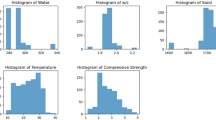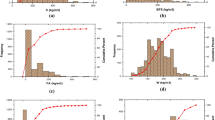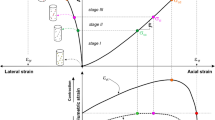Abstract
The California bearing ratio (CBR) is commonly employed within the field of geotechnical engineering and its associated applications, including but not limited to highway embankments, earth dams, and bridge abutments. This index can typically be ascertained through laboratory analyses or field test procedures. Nonetheless, the method of determining CBR is both time- and cost-intensive. Consequently, this research endeavors to present three hybrid models that integrate the multi-layer perceptron model (MLP) with three meta-heuristic algorithms, namely, the flow direction algorithm (FDA), Prairie dog optimization (PDO), and red deer algorithm (RDA). These models offer a cost-effective and efficient methodology for predicting CBR values while concurrently exhibiting enhanced precision in dealing with real-world complexities. The present study determined that 70% of the developed hybrid models were assigned to the training phase, while the 30% remaining were designated testing models. This study assessed the influence of eight distinct factors on the anticipated CBR values. To assess the precision of the models developed for two categories, an analysis is conducted that involves a comparative examination of projected outcomes versus observed results. This evaluation utilizes five distinct statistical measures, namely, the coefficient of determination (R2), root mean squared error (RMSE), mean squared error (MSE), mean absolute relative error (MARE), and uncertainty (U95%).







Similar content being viewed by others
Data availability
The authors do not have permissions to share data.
References
Alawi M, Rajab M (2013) Prediction of California bearing ratio of subbase layer using multiple linear regression models. Road Mater Pavem Design 14(1):211–219
Aytekin M (2000) Soil mechanics. Academy Publishing House, Trabzon
Bai J, Wild S, Ware JA, Sabir BB (2003) Using neural networks to predict workability of concrete incorporating metakaolin and fly ash. Adv Eng Softw 34(11–12):663–669
Basma AA, Kallas N (2004) Modeling soil collapse by artificial neural networks. Geotech Geol Eng 22:427–438
Behnam S, Tejani GG, Kumar S (2023) Predict the maximum dry density of soil based on individual and hybrid methods of machine learning. Adv Eng Intell Syst 002(03)
Black WPM (1962) A method of estimating the California bearing ratio of cohesive soils from plasticity data. Geotechnique 12(4):271–282
Das SK, Basudhar PK (2008) Prediction of residual friction angle of clays using artificial neural network. Eng Geol 100(3–4):142–145
Erzin Y, Turkoz D (2016) Use of neural networks for the prediction of the CBR value of some Aegean sands. Neural Comput Appl 27:1415–1426
Ezugwu AE, Agushaka JO, Abualigah L, Mirjalili S, Gandomi AH (2022) Prairie dog optimization algorithm. Neural Comput Appl 34(22):20017–20065
Fathollahi-Fard AM, Hajiaghaei-Keshteli M, Tavakkoli-Moghaddam R (2020) Red deer algorithm (RDA): a new nature-inspired meta-heuristic. Soft Comput 24:14637–14665
Ghorbani A, Hasanzadehshooiili H (2018) Prediction of UCS and CBR of microsilica-lime stabilized sulfate silty sand using ANN and EPR models; application to the deep soil mixing. Soils Found 58(1):34–49
Gunaydin O, Gokoglu A, Fener M (2010) Prediction of artificial soil’s unconfined compression strength test using statistical analyses and artificial neural networks. Adv Eng Softw 41(9):1115–1123
Ho LS, Tran VQ (2022) Machine learning approach for predicting and evaluating California bearing ratio of stabilized soil containing industrial waste. J Clean Prod 370:133587
Hoogland JL (1995) The black-tailed prairie dog: social life of a burrowing mammal. University of Chicago Press, Chicago
Jenson SK, Domingue JO (1988) Extracting topographic structure from digital elevation data for geographic information system analysis. Photogramm Eng Remote Sens 54(11):1593–1600
Kahraman S, Gunaydin O, Alber M, Fener M (2009) Evaluating the strength and deformability properties of Misis fault breccia using artificial neural networks. Expert Syst Appl 36(3):6874–6878
Karami H, Anaraki MV, Farzin S, Mirjalili S (2021) Flow direction algorithm (FDA): a novel optimization approach for solving optimization problems. Comput Ind Eng 156:107224
Lei Y, Zhou S, Luo X, Niu S, Jiang N (2022) A comparative study of six hybrid prediction models for uniaxial compressive strength of rock based on swarm intelligence optimization algorithms. Front Earth Sci. https://doi.org/10.3389/feart.2022.930130
Masoumi F, Najjar-Ghabel S, Safarzadeh A, Sadaghat B (2020) Automatic calibration of the groundwater simulation model with high parameter dimensionality using sequential uncertainty fitting approach. Water Supply 20(8):3487–3501
Moayedi H, Hayati S (2018) Applicability of a CPT-based neural network solution in predicting load-settlement responses of bored pile. Int J Geomech 18(6):6018009
Ngoc-Nguyen L, Khatir S, Nguyen H-Q, Bui-Tien T, Wahab MA (2023). A practical review of prairie dog optimization algorithm in solving damage identification problems in engineering structures. In: Proceedings of the International Conference of Steel and Composite for Engineering Structures: ICSCES 2022, Springer, pp: 296–306
Noriega L (2005) Multilayer perceptron tutorial. School Comput Stafford Univ 4:5
O’Callaghan JF, Mark DM (1984) The extraction of drainage networks from digital elevation data. Comput vis Graph Image Process 28(3):323–344
Patel RS, Desai, MD (2010) CBR predicted by index properties for alluvial soils of South Gujarat. In: Proceedings of the Indian Geotechnical Conference, Mumbai, pp 79–82
Ramchoun H, Ghanou Y, Ettaouil M, Janati Idrissi MA (2016) Multilayer perceptron: architecture optimization and training
Shiblee M, Kalra PK, Chandra B (2009) Time series prediction with multilayer perceptron (MLP): a new generalized error based approach. In: Advances in Neuro-Information Processing: 15th International Conference, ICONIP 2008, Auckland, New Zealand, November 25–28, 2008, Revised Selected Papers, Part II 15, Springer, pp: 37–44.
Taskiran T (2010) Prediction of California bearing ratio (CBR) of fine grained soils by AI methods. Adv Eng Softw 41(6):886–892
Varghese VK, Babu SS, Bijukumar R, Cyrus S, Abraham BM (2013) Artificial neural networks: a solution to the ambiguity in prediction of engineering properties of fine-grained soils. Geotech Geol Eng 31:1187–1205
Xie G, Wang S, Zhao Y, Lai KK (2013) Hybrid approaches based on LSSVR model for container throughput forecasting: a comparative study. Appl Soft Comput 13(5):2232–2241
Xue X, Wei Y (2020) A hybrid modelling approach for prediction of UCS of rock materials. Comptes Rendus Mécanique 348(3):235–243
Yang X-S, Deb S (2009) Cuckoo search via Lévy flights. In: 2009 World Congress on Nature & Biologically Inspired Computing (NaBIC), IEEE, pp: 210–214
Yildirim B, Gunaydin O (2011) Estimation of California bearing ratio by using soft computing systems. Expert Syst Appl 38(5):6381–6391
Zitar RA, Abualigah L, Al-Dmour NA (2021) Review and analysis for the red deer algorithm. J Ambient Intell Hum Comput: 1–11.
Author information
Authors and Affiliations
Contributions
JC: writing—original draft preparation, conceptualization, supervision, project administration.
Corresponding author
Ethics declarations
Conflict of interest
The authors declare no competing of interests.
Additional information
Publisher's Note
Springer Nature remains neutral with regard to jurisdictional claims in published maps and institutional affiliations.
Rights and permissions
Springer Nature or its licensor (e.g. a society or other partner) holds exclusive rights to this article under a publishing agreement with the author(s) or other rightsholder(s); author self-archiving of the accepted manuscript version of this article is solely governed by the terms of such publishing agreement and applicable law.
About this article
Cite this article
Chen, J. Prediction of California bearing ratio using multi-layer perceptron model based on multiple meta-heuristic optimizers. Multiscale and Multidiscip. Model. Exp. and Des. (2024). https://doi.org/10.1007/s41939-023-00336-9
Received:
Accepted:
Published:
DOI: https://doi.org/10.1007/s41939-023-00336-9




